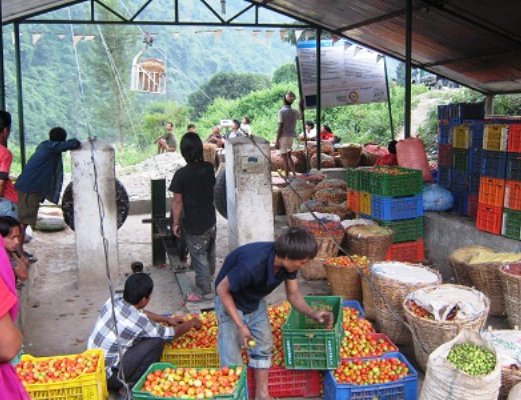
The passengers travelling between Kathmandu and Pokhara on the Prithvi Highway must have noticed tons of vegetable lying by the roadside at Fishling. Only a few might notice, however, that the gravity ropeway brings the vegetables from the top of the hill down there and takes other products from there up to the hill.
The Bhumlichok Ropeway connects the Devisthan village of Bhumlichowk-9 with Fishling Bazzar at Darechowk -2 of Chitwan district along the Prithivi highway. Installed in 2009, the ropeway is a symbol of transformation of the society.
Similarly, equally unnoticed may be the Ghyalchowk ropeway, which connects ward no 6 of Ghyalchowk with the Jogimara VDC of Dhading district. The lower station of the 1163m long ropeway lies at the Prithivi Highway, near the Hugdi Bazaar. Installed in 2010, the ropeway has also changed the local life drastically.
This shows how a clever use of the gravitational force can help people get their produce to the market. For the rural people living in remote mountains, transport, otherwise, is difficult.
Before the construction of the ropeways, getting vegetables to the market used do be exhausting and dangerous. Now the situation has changed. This mode of transport has also reduced the burden of women and children who carried heavy loads on their back, down treacherous, winding dirt tracks, until a decade ago.
Bhumlichowk and Ghyalchowk Gravity Goods Ropeways of Gorkha district, are the symbol of transformation in the livelihood of people, as well as protecting the environment.
According to a study made by Practical Action Nepal, it could take two people over three hours to carry a 120kg load of apples 1.3 km down a steep mountain path – and that’s just the first part of the grueling journey to market. Now, with a gravity ropeway, it takes less than five minutes to carry the apples over the same distance. Depending solely on gravitational force – and using no external power – the gravity ropeways are providing simple, inexpensive solutions to the local transport problems.
Under the Access for Opportunities project, 2007 to 2012, Practical Action installed 15 Gravity Goods Ropeways in 4 districts of Nepal.
With these examples, Practical Action Nepal has shown how gravity ropeways can help improve the livelihood of the people and protect the environment. Experts recently discussed the use of gravity ropeways as carbon neutral pathways in light of these examples.
At a time when Nepal’s mountains are under a severe threat of disaster due to rampant road construction, speakers at the Symposium on Carbon Neutral Pathways in Nepal with a Special Focus on Ropeways and Electric Transport stressed the need to choose ropeways and electric transport as better alternatives.
According to a book published by Nepal Water Conservation Foundation and Kathmandu Electric Vehicle Alliance in 2004, the Ropeways in Nepal revealed that ropeway technology is both mountain friendly and climate friendly.
The book said that ropeways are eight times faster than an equivalent green road. It said ropeways run on hydroelectricity, especially small hydro plants in the rural areas, whereas energy for trucks on roads comes from imported diesels.
Organized by Nepal Academy of Science and Technology, Nepal Water Conservation Foundation, Toni Hagen Foundation and Lund University for Sustainable Development, scientists, experts and politicians took part in the program.
“Our ropeways have shown how they can transform the rural society and how can they can help protect the environment," said Sujan Piya Ph. D, head of program, Agriculture, Food Security and Markets of Practical Action. "We are sharing our expertise with various government agencies particularly DOLIDAR."
Although as early 1950s, renowned Swiss development expert Toni Hagen recommended ropeways as the best model of transport in Nepal, the country is yet to go with a massive campaign in that direction.
Since her father late Toni Hagen started to prescribe the gravity ropeways in Nepal, Dr. Katrin Hagen, chairman of Toni Hagen Foundation, has seen the expansion of ropeways can save Nepal’s fragile eco-system.
With technology and successful experiment used by Practical Action Nepal in the use of gravity ropeways, the government can now replicate the technology for the betterment of livelihood of poor people and save the fragile environment.
- TANAHU HYDROPOWER PROEJCT: A Significant Achievement
- Apr 15, 2024
- AMBASSADOR HANAN GODAR: Sharing Pain With A Nepali Family
- Mar 30, 2024
- VISIT OF KfW AND EIB TO NEPAL : Mission Matters
- Mar 25, 2024
- NEPAL BRITAIN SOCIETY: Pratima Pande's Leadership
- Mar 24, 2024
- NEPAL ARMY DAY: Time To Recall Glory
- Mar 15, 2024
















